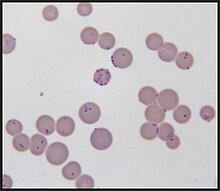Mycoplasma
| This airticle is a stub. Ye can help Wikipaedia bi expandin it. |
The "Scots" that wis uised in this airticle wis written bi a body that haesna a guid grip on the leid. Please mak this airticle mair better gin ye can. |
Mycoplasma is a genus o bacteria that lack a cell waw aroond thair cell membrane.[1] Wioot a cell waw, thay are unaffectit bi mony common antibiotics such as penicillin or ither beta-lactam antibiotics that target cell waw synthesis. They can be parasitic or saprotrophic. Several species are pathogenic in humans, includin M. pneumoniae, which is an important cause o atypical pneumonia an ither respiratory disorders, an M. genitalium, which is believed tae be involved in pelvic inflammatory diseases. Mycoplasma are the smawest bacterial cells yet discovered,[2] can survive wioot oxygen an are teepically aboot 0.1 µm in diameter. Hunders o mycoplasmas infect animals.[3]
| Mycoplasma | |
|---|---|

| |
| Mycoplasma haemofelis | |
| Scientific classification | |
| Domain: | Bacteria |
| Phylum: | Tenericutes |
| Cless: | Mollicutes |
| Order: | Mycoplasmatales |
| Faimily: | Mycoplasmataceae |
| Genus: | Mycoplasma J.Nowak 1929 |
| Mycoplasmosis | |
|---|---|
| Specialty | Infectious disease |
References
eedit- ↑ Ryan KJ, Ray CG (editors) (2004). Sherris Medical Microbiology (4th ed.). McGraw Hill. pp. 409–12. ISBN 0-8385-8529-9.CS1 maint: extra text: authors leet (link)
- ↑ Richard L. Sweet, Ronald S. Gibbs (2002). Infectious Diseases of the Female Genital Tract. Lippincott Williams & Wilkins, 2009.
- ↑ Larsen, Bryan; Hwang, Joseph (2010). "Mycoplasma, Ureaplasma, and Adverse Pregnancy Outcomes: A Fresh Look". Infectious Diseases in Obstetrics and Gynecology. 2010: 1–7. doi:10.1155/2010/521921. ISSN 1064-7449.